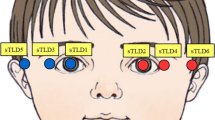Background and Purpose:
Stereotactic radiosurgery of intracranial tumors and vascular malformations can be performed by either a linear accelerator (Linac) or gamma knife. The aim of this first study on patients was to determine the radiation exposure of organs at risk and assess the risk for late effects including secondary tumors and/or hereditary disorders after stereotactic Linac radiosurgery.
Material and Methods:
Thermoluminescent dosimetry (TLD) measurements were done on 21 consecutively admitted patients with various intracranial lesions scheduled for Linac radiosurgery. The TLD chips were placed on the eyelid, thyroid, breast and the regions of the ovary or testes.
Results:
The mean doses in organs at risk were 276 ± 200 mGy (eye lens), 155 ± 83 mGy (thyroid), 47 ± 22 mGy (breast), 20 ± 12 mGy (ovary), and 9 ± 3 mGy (testes). The doses decreased significantly with a larger distance from the isocenter.
Conclusion:
The absorbed doses to the extracranial organs at risk in patients undergoing Linac radiosurgery were very low, ranging from 0.025% (testes) to 0.76% (eye lens) of the mean maximum target dose (36 Gy). Nevertheless, while the majority of radiosurgery patients have benign tumors or arteriovenous malformations and their life expectancy is long, all doses should be kept as low as reasonably achievable. This could be accomplished by the use of modern irradiation techniques including conformal beams with micro–multileaf collimator and avoiding beams directed to the trunk.
Hintergrund und Ziel:
Die stereotaktische Radiochirurgie zur Behandlung intrakranieller Tumoren und Gefäßfehlbildungen kann entweder am Linearbeschleuniger (Linac) oder am Gamma–Knife durchgeführt werden. Ziel dieser ersten Studie am Patienten war, die Strahlendosen an extrakraniellen Risikoorganen bei der stereotaktischen Linac–Radiochirurgie zu bestimmen und das potentielle Risiko der Entwicklung von Strahlenspätfolgen inkl. sekundärer Tumoren und hereditärer Erkrankungen nach einer stereotaktischen Linac–Radiochirurgie abzuschätzen.
Material und Methodik:
Thermolumineszenzdosimetrische (TLD) Messungen wurden an 21 wegen unterschiedlicher Hirnerkrankungen mittels Linac–Radiochirurgie konsekutiv behandelten Patienten durchgeführt. Die TLD–Chips waren an Augenlid, Schilddrüse, Brustdrüse, Hoden– und der Eierstockregion angeklebt.
Ergebnisse:
Die mittleren gemessenen Strahlendosen im Bereich der Risikoorgane betrugen 276 ± 200 mGy (Augenlinse), 155 ± 83 mGy (Schilddrüse), 47 ± 22 mGy (Brust), 20 ± 12 mGy (Ovar) und 9 ± 3 mGy (Hoden). Diese Strahlendosen nahmen signifikant mit größerer Entfernung vom Isozentrum ab.
Schlussfolgerung:
Die gemessenen Strahlendosen an den extrakraniellen Risikoorganen während Linac–Radiochirurgie waren sehr niedrig. Sie lagen zwischen 0,025% (Hoden) und 0,76% (Augenlinse) der mittleren applizierten Maximaldosis im Zielvolumen (36 Gy). Da die Mehrheit der radiochirurgisch zu behandelnden Patienten an gutartigen Tumoren oder arteriovenösen Malformationen erkrankt ist und eine lange Lebenserwartung hat, sind potentielle Langzeit–Strahlenfolgen durch den Einsatz von Mikro–Multileaf–Kollimatoren und Vermeidung von Einstrahlrichtungen entlang der Körperachse zu minimieren.
Similar content being viewed by others
Author information
Authors and Affiliations
Corresponding author
Rights and permissions
About this article
Cite this article
Maarouf, M., Treuer, H., Kocher, M. et al. Radiation Exposure of Extracranial Organs at Risk during Stereotactic Linac Radiosurgery. Strahlenther Onkol 181, 463–467 (2005). https://doi.org/10.1007/s00066-005-1391-x
Received:
Accepted:
Issue Date:
DOI: https://doi.org/10.1007/s00066-005-1391-x




